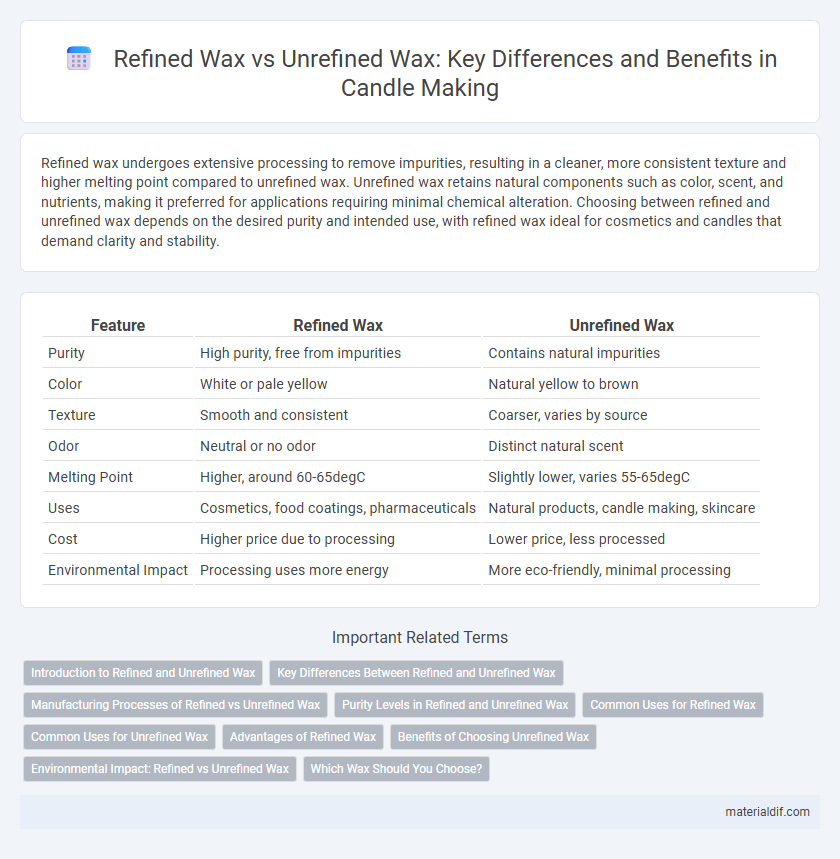Refined wax undergoes extensive processing to remove impurities, resulting in a cleaner, more consistent texture and higher melting point compared to unrefined wax. Unrefined wax retains natural components such as color, scent, and nutrients, making it preferred for applications requiring minimal chemical alteration. Choosing between refined and unrefined wax depends on the desired purity and intended use, with refined wax ideal for cosmetics and candles that demand clarity and stability.
Table of Comparison
| Feature | Refined Wax | Unrefined Wax |
|---|---|---|
| Purity | High purity, free from impurities | Contains natural impurities |
| Color | White or pale yellow | Natural yellow to brown |
| Texture | Smooth and consistent | Coarser, varies by source |
| Odor | Neutral or no odor | Distinct natural scent |
| Melting Point | Higher, around 60-65degC | Slightly lower, varies 55-65degC |
| Uses | Cosmetics, food coatings, pharmaceuticals | Natural products, candle making, skincare |
| Cost | Higher price due to processing | Lower price, less processed |
| Environmental Impact | Processing uses more energy | More eco-friendly, minimal processing |
Introduction to Refined and Unrefined Wax
Refined wax undergoes processes such as bleaching and filtering to remove impurities, resulting in a cleaner, more consistent product commonly used in cosmetics, candles, and polishes. Unrefined wax retains natural components, including color, scent, and nutrients, making it preferred for organic skincare and holistic applications. The choice between refined and unrefined wax depends on the desired purity, texture, and functional properties for specific industrial or consumer needs.
Key Differences Between Refined and Unrefined Wax
Refined wax undergoes extensive processing to remove impurities, resulting in a cleaner, more transparent, and consistent texture ideal for cosmetics and candle making. Unrefined wax retains natural components such as pollen, propolis, and color variations, offering richer nutrients and a characteristic aroma favored in natural skincare products. The key differences lie in their purity, aroma, texture, and suitability for specific applications where either processed cleanliness or natural essence is prioritized.
Manufacturing Processes of Refined vs Unrefined Wax
Refined wax undergoes a series of purification steps including bleaching, filtering, and deodorizing to remove impurities, colorants, and odors, resulting in a consistent and clean final product. Unrefined wax maintains its natural state, preserving impurities, color, and scent due to minimal processing, typically involving simple filtering or melting. Manufacturing processes for refined wax prioritize achieving high purity standards for industrial and cosmetic applications, whereas unrefined wax retains raw components valued in artisan and natural product markets.
Purity Levels in Refined and Unrefined Wax
Refined wax undergoes extensive processing to remove impurities, resulting in a higher purity level compared to unrefined wax, which retains natural contaminants and color variations. The purification process in refined wax enhances its consistency, making it ideal for cosmetics and pharmaceuticals that require stringent purity standards. Unrefined wax maintains more natural elements, offering a raw, organic quality but with lower purity, suitable for applications where such characteristics are valued over absolute cleanliness.
Common Uses for Refined Wax
Refined wax is widely used in cosmetics, candles, and food coatings due to its purity, consistent texture, and neutral scent. Its processed nature allows for better blending with fragrances and colors, making it ideal for high-quality skincare products and decorative candles. Refined wax also finds applications in pharmaceuticals and packaging, where controlled melting points and cleanliness are crucial.
Common Uses for Unrefined Wax
Unrefined wax is commonly used in natural skincare products due to its high content of beneficial nutrients and minimal chemical processing. It is favored for lip balms, salves, and organic cosmetics where preserving natural antioxidants and vitamins is essential. This type of wax also serves in candle making, offering a more natural scent and color compared to refined wax.
Advantages of Refined Wax
Refined wax offers a purer composition with fewer impurities, resulting in a cleaner burn and less soot production compared to unrefined wax. Its consistent texture and color enhance the visual appeal and performance in candle making and cosmetic applications. The controlled melting point of refined wax provides greater stability and longer shelf life, making it ideal for high-quality, professional-grade products.
Benefits of Choosing Unrefined Wax
Unrefined wax retains natural impurities, offering higher levels of nutrients, antioxidants, and essential oils compared to refined wax, which undergoes bleaching and chemical treatments. This purity enhances its moisturizing and healing properties, making it ideal for skincare and therapeutic applications. Choosing unrefined wax supports eco-friendly practices by minimizing chemical processing and preserving natural biodiversity.
Environmental Impact: Refined vs Unrefined Wax
Refined wax undergoes extensive processing that often removes natural impurities but increases energy consumption and chemical use, leading to a higher environmental footprint. Unrefined wax retains its natural components, requiring less processing and preserving beneficial nutrients, resulting in a more eco-friendly and sustainable product. Choosing unrefined wax supports reduced chemical emissions and energy usage, aligning with greener production practices.
Which Wax Should You Choose?
Refined wax offers a cleaner, more consistent texture, making it ideal for cosmetic and candle-making applications where purity and appearance matter. Unrefined wax retains more natural compounds, providing better moisturizing properties but with a distinct color and aroma, often preferred in natural skincare products. Choose refined wax for smooth finishes and hypoallergenic needs, while unrefined wax suits formulations emphasizing natural benefits and organic qualities.
Refined Wax vs Unrefined Wax Infographic

 materialdif.com
materialdif.com